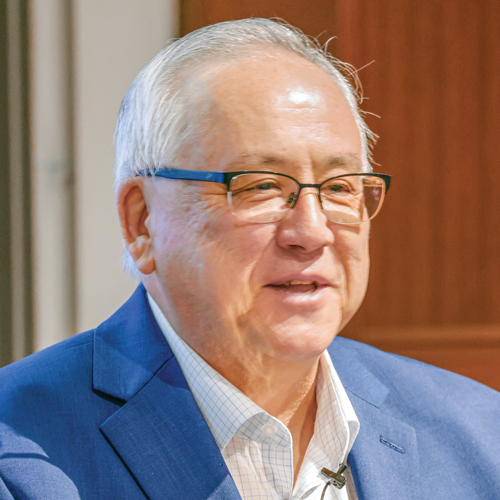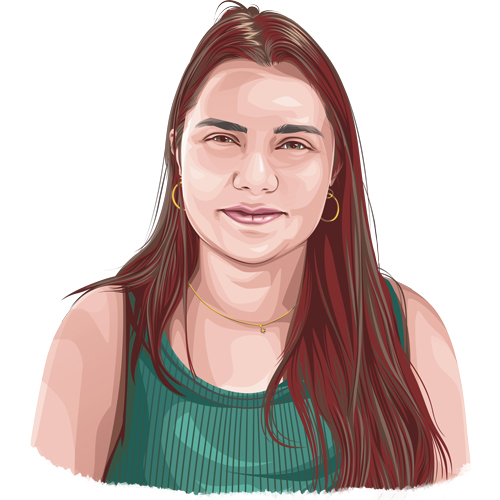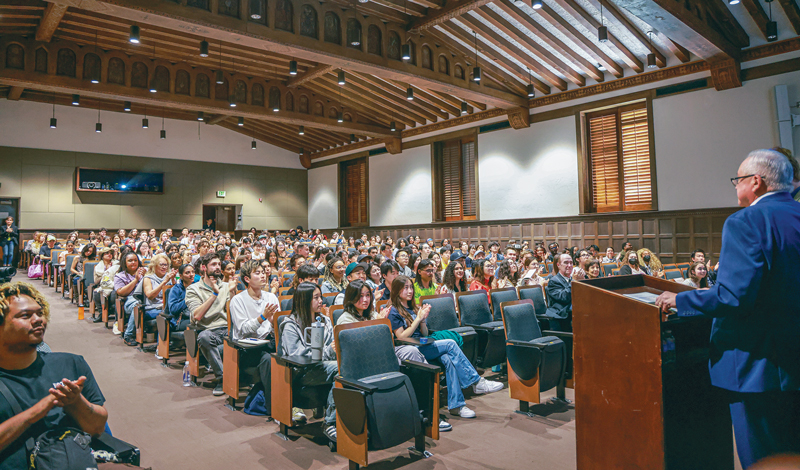LOS ANGELES—“Where does your sense of urgency come from, and how can we cultivate it in ourselves?”
The question came from a youth, one of 270 who gathered on April 27 at the University of California, Los Angeles (UCLA), to commemorate the anniversary of Ikeda Sensei’s lecture, “The Enduring Self,” delivered at UCLA 50 years earlier. A teacher, the youth was one of many keenly interested in the philosophy of Soka.
Edward M. Feasel, Soka University of America (SUA) president and keynote speaker, referred to a diagram showing concentric circles. The center represented an individual person, with each ensuing ring representing broadening levels of community stretching out to the world. Peace occurs, he had said, when within each circle thrives respect for the dignity of life.
“Begin with what’s closest to you,” Feasel told the youth. “When I was growing up, my family experienced financial hardship. Because of that experience, I became an economist to create a world in which financial hardship wouldn’t be a matter of survival.”

Edward M. Feasel
Soka University of America President
A New Path for Humanity
It was at UCLA, on April 1, 1974, that Sensei presented “The Enduring Self”—his first university address outside of Japan. Aware that universities would profoundly shape the 21st century, he chose UCLA as the launching point from which to convey the principles of a new humanism, rooted in Buddhist thought, to universities around the world.
In “The Enduring Self,” Sensei emphasized the need for humanity to break away from the cold utilitarianism of that century and move toward a century of respect for the dignity of life.[1] Delivered in the latter part of humanity’s bloodiest century and at the height of the Cold War, the address unearths the roots of human violence and reveals fundamental principles of peace.
Half a century later, the youth in attendance explored the concepts Sensei introduced in his lecture: the lesser versus the greater self; the path of moderation born of self-mastery; how one’s attachment to the transient is what causes great suffering; and how the enduring, or eternal, self is directly connected with the great web of cosmic life.
As part of the meeting, David Sedmak, of Los Angeles, shared his recollections of attending the UCLA lecture 50 years ago. “Sensei put the question to us: Would humankind take the path of humanity or would it go down the path of barbarism?”
For the 50 years that followed, Sedmak navigated life with his mentor’s message as his compass: changing the world begins with me.
“I don’t know of any world figure who believed more in young people,” he said to the youth in the audience, “in your passion, in your heart, in your capability to shape a more humanistic future.”
The Significance of the Address
President Feasel opened his lecture by putting the 1974 UCLA milestone in the broader context of Sensei’s enduring efforts for peace. This was the first of 32 university lectures that Sensei would give over the course of his life.
It took place on the heels of his far-reaching dialogues with the eminent British historian Arnold J. Toynbee, whose landmark work A Study of History introduced the theory of “challenge and response.” The crucial factor in a civilization’s survival, Toynbee proposed, is how it responds to inevitable and repeated challenges.
“Ikeda offered a new way to respond, a way forward to create peace based on the Buddhist value of the dignity of life,” Feasel said.
A month after the UCLA lecture, Sensei, as a citizen-diplomat, embarked on a series of visits to China, the Soviet Union and the U.S. between 1974 and 1975 to ease tensions among the countries. And shortly after establishing the Soka Gakkai International in January 1975, he visited China again, creating a path for the country to complete the Treaty of Peace and Friendship with Japan in 1978.
“The UCLA speech was an important exposition of Buddhist humanism to the West and to the world, based on his thoughts and efforts during the Cold War to move the world in the direction of peace,” Feasel said.
Awakening to the Greater Self
The lesser and greater self, the oneness of life and death, the Middle Way and the immutable law of the universe—these, to Feasel, were the guideposts Sensei staked at the crossroads of our future, fundamental principles to guide the people of the 21st century on their quest toward their greater selves.
“While we are individual human beings, we’re part of a larger web of life,” Feasel said. “And with that self-realization, we can create change in our own lives and also in society.”
Displaying on screen a photo of the expansive ocean, Feasel said, “For me, the ocean symbolizes the greater self. There’s the ocean that we’re all a part of, but we’ve appeared as individual waves and we impact one another, in good or bad ways.”
Education for Global Citizenship
Speaking of SUA’s mission to foster global citizens, Feasel said it was “another way for individuals to understand the greater self.”
He recalled his encounter in 1993 with Nobel laureate Linus Pauling, with whom Sensei met for dialogue.
Feasel was driving Pauling from the airport when another person in the car asked the chemist and peace activist if he had any regrets in life. Pondering this, Pauling responded that his one regret was giving up, years earlier, on a particularly difficult chemistry problem. For 10 years, said Pauling, he’d let it lie, putting the problem out of mind. Eventually, he returned to the problem, solved it, and in so doing, made one of his most significant contributions to the field. His one regret, he said, was not having worked hard enough to solve the problem the first time around. He regretted that he hadn’t made this contribution to humanity sooner.
To Feasel, Pauling’s regret expressed an essential quality of a global citizen. “They have this ethic to work for the betterment of society,” he said.
As SUA’s president, Feasel is often asked what Soka means. Each time, he recalls Sensei’s definition: “The capacity to find meaning, to enhance one’s own existence and contribute to the well-being of others, under any circumstances.”[2] To foster leaders with such a capacity—this is the mission driving the education offered at SUA.
The Global Import of Local Actions
Whoever we are, wherever we may be, Feasel encouraged those in attendance, we should bear in mind the global import of our local actions. When each person strives to transform their immediate environment based on a sense of belonging and commitment to the world at large, it will not fail to move the world along the path of peace.
Feasel recalled an encounter at the age of 17 with Sensei at an event attended by U.N. officials. Sensei was seated outside in a circle with them, discussing whatever one discusses with U.N. officials. Feasel stood a little ways away, watching. Somehow, Sensei spotted him there, raised a hand, smiled and waved. Mid-conversation with international dignitaries, Sensei had stopped to acknowledge a 17-year-old boy. It was, to Feasel, an apt expression of Sensei’s philosophy of global citizenship—a philosophy of respect for all people, regardless of status, influence, age, etc.
Feasel recalled another memory, of watching a sunset with Sensei. “What a brilliant sunset,” Sensei said. “Our lives should be like this at the moment of our death, illuminating the entire horizon.” Pondering that sunset, Feasel put a question to the room. “For what greater purpose,” he asked, “can we live our lives?”
The Middle Way Of Life

by Albert Lam
Studying Economics at University of California, Los Angeles
The Middle Way of living life—of trying to understand people where they are and being open to other perspectives—is something that I’ve found myself practicing for most of my life. This way of life has helped me meet a lot of amazing people, learn many interesting things and be a better person. It was nice to hear this perspective said in an already thought-out manner.
I want to learn more about the greater self. I’m surprised because I thought Buddhism was about detaching yourself from worldly desires—which is the opposite of materialism. But finding a balance between the two would be great. For example, I personally love cars—how they sound, drive and look—but I know they cause pollution. So I’m studying economics to become an urban planner and help people be less reliant on cars. Maybe that’s one way to blend the materialistic with the sustainable parts of life. And I hope that, if we continue thinking in this way, we can minimize the impact of technology and harmonize it with our way of life.
A Part of Something Bigger

by Morgana Donatti
Studying International Studies at Soka University of America
The idea that both the greater and lesser self exist together stood out to me. I take it as our best self cannot exist without our worst self. They’re not separate things, but they both make up who we are.
Another thing I took away was the importance of thinking of yourself as a global citizen. Even if we come from different places, we are all people, and we need to act with compassion toward one another. I think that when you realize that you’re a part of something bigger, that you’re united in this, it’s easy to apply this in your life and be more understanding. You have no prejudice toward others because we’re all part of the same whole.
These concepts in Buddhism are a beautiful way to see life. Although I don’t follow a religion, I do feel that knowing about and applying these concepts are important for our lives.
—Prepared by the World Tribune staff
May 10, 2024, World Tribune, pp. 6–8
You are reading {{ meterCount }} of {{ meterMax }} free premium articles

